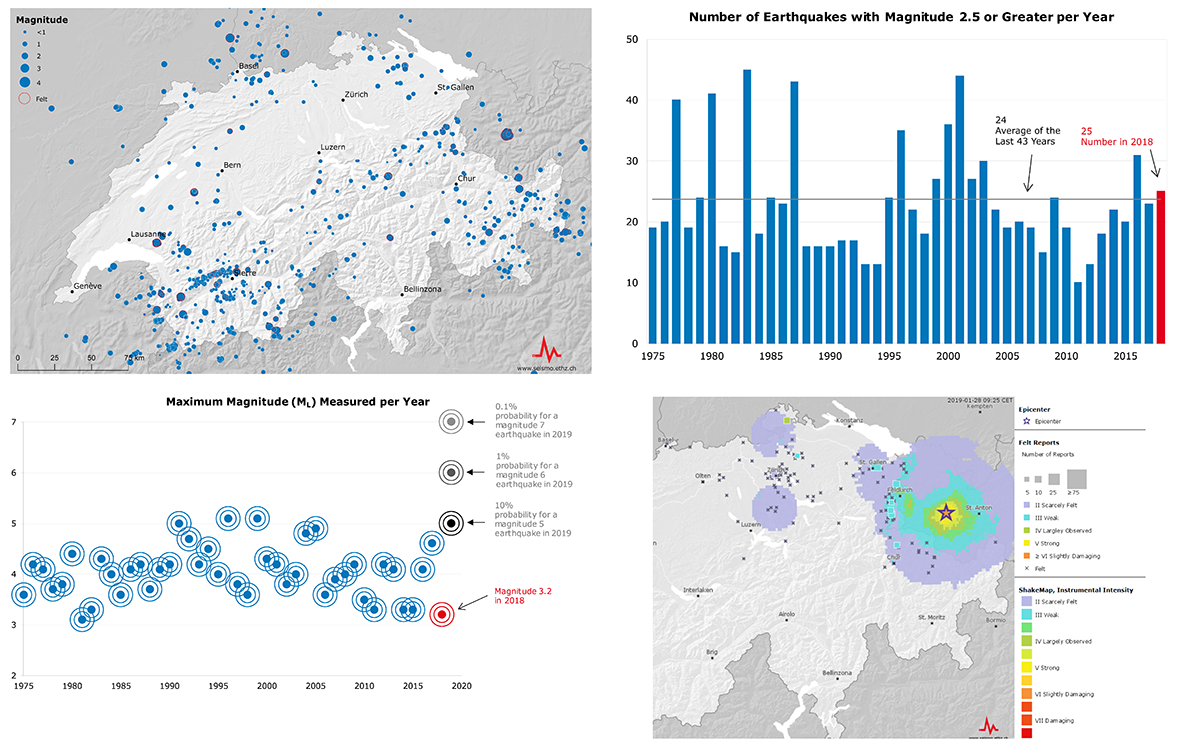2019-01-28
Earthquakes in Switzerland in 2018
Last year, the Swiss Seismological Service (SED) at ETH Zurich recorded more than 900 earthquakes with magnitudes of between -0.2 and 4.1 in Switzerland and its neighbouring countries. 25 of these quakes had a magnitude of 2.5 or more. Earthquakes of this size can usually be felt by the local population. So 2018 goes down as an average earthquake year, albeit one from which we can learn a lot. Because even very small quakes provide valuable information about the subsurface and thus make it easier to estimate future seismic activity.
Thanks to Switzerland's dense and highly sensitive earthquake measuring system, even the smallest quakes almost anywhere in Switzerland can be recorded and analysed. Earthquakes indicate the locations of more (or less) active faults today or over the years and provide insights into fracture processes deep beneath our feet. The seismic waves caused by earthquakes also offer data on the subsurface through which they pass. For example, the speed at which they travel tells something about the physical properties of the rock at the locations in question. These findings contribute towards more accurate risk assessment. So even 'quieter' earthquake years yield valuable knowledge.
Read more...The two strongest earthquakes felt over the largest areas by the Swiss population occurred on 17 January and 1 February 2018 in Austria's Kloster Valley (Montafon) near the Swiss border. Both quakes reached a magnitude of 4.1. The most powerful earthquake in Switzerland itself, with a magnitude of 3.2, occurred on 23 August near the twin-peaked mountain Dents de Morcles in the Canton of Valais. The SED received around 400 reports from people who felt this quake, mainly in the Rhone Valley, whose soft subsurface particularly intensified the shaking. Other earthquakes, some of which were also clearly felt, occurred on 15 and 16 May near Châtel-St-Denis in the Canton of Fribourg (with magnitudes of 3.1 and 2.9), on 3 November near Martigny in the Canton of Valais (magnitude 2.9) and on 29 December near Fribourg (magnitude 2.9). Only the quakes in the Kloster Valley ended up causing minor damage, such as cracks in buildings' façades.
In addition, last year saw the occurrence of some remarkable earthquake swarms. A swarm entails numerous quakes occurring over a fairly long period, without there being any clear sequence of foreshocks, mainshock and aftershocks. The most notable swarm involved a series of earthquakes northeast of St. Léonard, near Sion in the Canton of Valais. This sequence was related to a fault that has repeatedly been associated with phases of heightened seismic activity since 2014. It is believed to be part of the Rhone-Simplon fault, which appears to be broken into separate segments in this area. Another earthquake sequence worth mentioning occurred in the border area between Italy, France and Switzerland, in the east of the Mont Blanc Massif. Last year, the SED pinpointed the locations of close to 100 earthquakes with magnitudes between 0 and 2.2 in that area.
In general, in 2018, as in previous years, most earthquake activity occurred in the Valais region, the Canton of Graubünden and the areas along the Alpine front. Despite this concentration of seismic activity, historically it has been shown that no parts of Switzerland are earthquake-free regions. Based on the long-term average, a serious earthquake with a magnitude of 6 or more occurs in the earthquake country Switzerland every 50 to 150 years.
